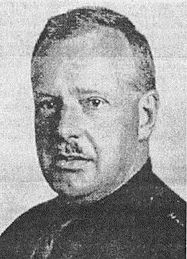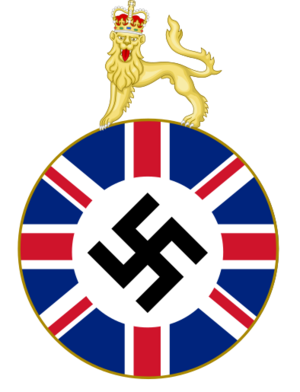Arnold Leese facts for kids
Quick facts for kids
Arnold Spencer Leese
|
|
|---|---|

Leese at an unspecified date
|
|
| Born |
Arnold Spencer Leese
16 November 1878 Lytham St Annes, Lancashire, England
|
| Died | 18 January 1956 (aged 77) London, England
|
| Nationality | British |
| Alma mater | Giggleswick School |
| Occupation | Veterinarian |
| Known for | Anti-Semitic writer and activist |
|
Notable work
|
A Treatise on the One-Humped Camel in Health and in Disease (1927), My Irrelevant Defence (1938), Out of Step: Events in the Two Lives of an Anti-Jewish Camel Doctor (1951) |
| Political party | British Fascists (1923-1925) National Fascisti (1925-1929) Imperial Fascist League (1929-1932) |
Arnold Spencer Leese (born 1878, died 1956) was a British politician with very strong, often extreme, views. He was also a skilled animal doctor, especially known for his work with camels. Later in his life, he became a leader of a political group called the Imperial Fascist League. He wrote many articles expressing his ideas, even after World War II.
Contents
Early Life and Education
Arnold Spencer Leese was born in Lytham St Annes, England, in 1878. His father was a manufacturer and artist. Arnold went to Giggleswick School. He was an only child and sometimes felt lonely growing up.
When his father passed away in 1894, his family faced money problems. This meant Arnold had to leave his boarding school. However, with financial help from his grandfather, he was able to attend the Royal College of Veterinary Surgeons.
Veterinary Career
After finishing his studies in 1903, Leese first worked with horses in London. In 1907, he moved to British India to work for the Civil Veterinary Department. There, he became an expert on camels. He spent six years in India, mainly in the North-West Frontier region.
Later, he moved to Italian Somaliland to work for the East Africa Government's veterinary department. He was there when World War I began in 1914. Leese was known as a top expert on camels. He wrote several articles about these animals and their illnesses.
One camel parasite, Thelazia leesei, was even named after him in 1910. In 1927, he published a book called A Treatise on the One-Humped Camel in Health and in Disease. This book was a key reference in India for 50 years.
During World War I, Leese joined the Royal Army Veterinary Corps. He worked as a Camel Purchase Officer for the Somaliland Camel Corps. He also served in France on the Western Front as a Veterinary Officer. During the war, he married May Winifred King. After the war, Leese returned to England and became a vet in Stamford, Lincolnshire. He worked there until he retired in June 1928.
Political Activities
In the early 1920s, Leese became interested in Italian Fascism. He admired the Italian leader Benito Mussolini. In 1923, he wrote a short pamphlet called Fascism for Old England. In it, he praised Mussolini and talked about how fascism could be important for Britain.
He joined the British Fascists (BF) soon after it started in 1923. He even created his own local branch in Stamford in 1924, which quickly grew to 80 members. However, Leese did not like that the BF allowed former socialists and Jewish people to join. He thought the party was not truly understanding fascism.
Leese believed that true fascism was about rejecting democracy. He also claimed that the way animals were slaughtered in Judaism (called Shechita) influenced his strong anti-Jewish views. He became friends with an economist named Arthur Kitson. Kitson convinced Leese that Jewish people controlled money and power.
Kitson gave Leese a copy of Protocols of the Learned Elders of Zion. Leese said that everything in this book "rang true" to him. In 1924, Leese was elected as a councillor in Stamford. He was one of the first elected fascist councillors in Britain.
Leese was generally unhappy with the British Fascists' policies. In 1925, he joined a new group called the National Fascisti (NF). When that group ended in 1927, he started his own 'Fascist League'. In October 1927, he stopped being a councillor. He retired in June 1928 and moved to Guildford, Surrey.
Imperial Fascist League
In 1929, Leese created his own group, the Imperial Fascist League (IFL). At first, it was similar to Italian fascism. But under the influence of Henry Hamilton Beamish, it began to focus heavily on anti-Jewish ideas. Leese used his own money to fund the IFL and its many publications.
In 1932, Oswald Mosley tried to get Leese to join his British Union of Fascists. While they were friendly at first, Leese soon criticized Mosley. He felt Mosley wasn't dealing with the "Jewish question" strongly enough. Leese even called Mosley's group "kosher fascists."
Leese's anti-Jewish views became his main political focus. These views grew more extreme after he visited Germany and met Julius Streicher. He then changed the IFL newspaper, The Fascist, to be like the German newspaper Der Stürmer. His beliefs included the idea that the "Aryan race" created civilization. He claimed that Aryans were in a constant fight with Jewish people.
In 1936, Leese was sent to prison for six months. This was because of articles he published in The Fascist called "Jewish Ritual Murder." After his release, he wrote another pamphlet, My Irrelevant Defence. In it, he defended his earlier claims that Jewish Passover celebrations involved the sacrifice of Christian children.
During World War II
Leese was one of the last fascist leaders to be held in the United Kingdom when World War II started. This was done under a special rule called Defence Regulation 18B. Leese claimed his main loyalty was to Britain. He had even criticized Adolf Hitler a bit since the war began.
He was very angry when he was ordered to be held in June 1940. Leese tried to avoid being captured by setting up secret hiding places. From these places, he published pamphlets criticizing the war. He was finally caught on November 9, 1940.
Still upset, Leese fought against his arrest and damaged his holding cell. Leese saw the war as a "Jew's War." However, he strongly disagreed with the agreement between Hitler and Stalin. He also criticized the Nazis for invading Norway. He called his political ideas "Racial Fascism." He did not like the term "National Socialism" used by the Nazi Party. However, he and other IFL members supported Nazi anti-Jewish views. He was released in 1944 due to health reasons after a big operation.
After the war, he offered to speak at William Joyce's trial. Along with Beamish, he was ready to give evidence about the "Jewish issue" at the Nuremberg Trials. Leese called these trials a "Jewish and Masonic affair," meant for revenge.
After the War
Soon after World War II ended, Leese started his own "Jewish Information Bureau." He also began publishing his own journal, Gothic Ripples. This journal mostly focused on attacking Jewish people. He wrongly believed there were 2.5 million Jewish people in Britain at the time. The magazine also had strong anti-black racist ideas.
Gothic Ripples was one of the first to promote what is now called Holocaust denial. In 1953, it stated that the story of six million Jewish people being killed by Hitler was a "fable." It even said they would have liked Hitler more if the number had been larger.
Leese went back to prison in 1947. He and seven other former IFL members were sentenced to one year. This was for helping German prisoners of war who were members of the Waffen SS escape. In 1948, Leese formed the National Workers Movement in London.
In 1951, he published his autobiography, Out of Step: Events in the Two Lives of an Anti-Jewish Camel Doctor. Leese was a mentor to Colin Jordan and John Tyndall. These two became important figures on the extreme right after the 1960s.
After Leese died, his wife, May Winifred Leese, helped fund far-right groups. His house in London, at 74 Princedale Road, Holland Park, was left to Colin Jordan. It became known as 'Arnold Leese House'. This property became Jordan's main base for groups like the White Defence League.
Leese died on January 18, 1956, at the age of 77.
Works
- Articles
- “The Jewish Method of Cattle Slaughter: The Legalised Cruelty of Shechita”. 1940.
- “Chinese Communism?”. Gothic Ripples, No. 49, 28 February 1949.
- “The Destruction of India: Its Cause and Prevention“. Undated.
- Books
- My Irrelevant Defence: Being Meditations Inside Gaol and Out on Jewish Ritual Murder. London: The I.F.L. Printing and Publishing Co., 1938.
- Swedish translation: Mitt Irrelevanta Försvar varandes Betraktelser bakom galler och ute om Judiska Ritualmord.
- Judaism in Action. New and enlarged edition, 1964.
- Gentile Folly: The Rothschilds. London: Angles News Service, 1940.
- The Jewish War of Survival. Arnold S. Leese, January 1945.
- Out of Step: Events in Two Lives of an Anti-Jewish Camel-Doctor. Guildford, UK. 1951.
- Excerpts available.
- The Era Of World Ruin! (The Era Of Democracy). Undated.
- Pamphlets
- Our Jewish Aristocracy. London: Imperial Fascist League, 1936. . 18 pages.
- Reprint: Hollywood, California: Sons of Liberty, 1936. 8 pages.
- The Mass Madness of Sept. 1938 and its Jewish Cause. London: Imperial Fascist League, 1938. . 15 pages.
- The Edict of Expulsion of 1290: A catalogue of recorded history surrounding Jewry under Angevin Kings of England, leading up to the Edict of Expulsion by King Edward I (Co-authored with Geoffrey H. Smith). Undated.
Images for kids



